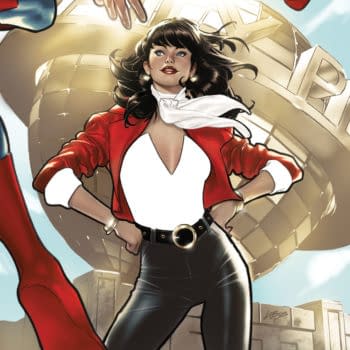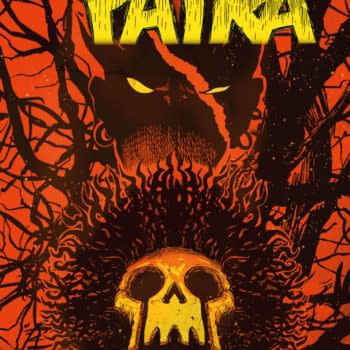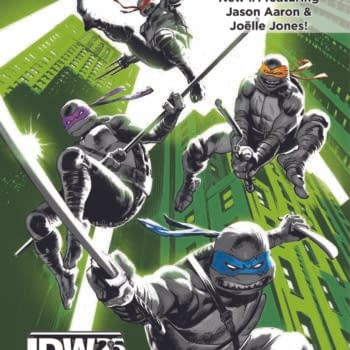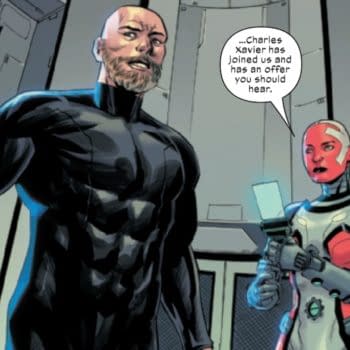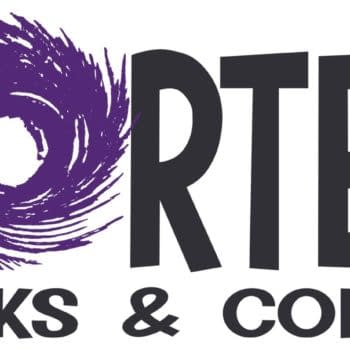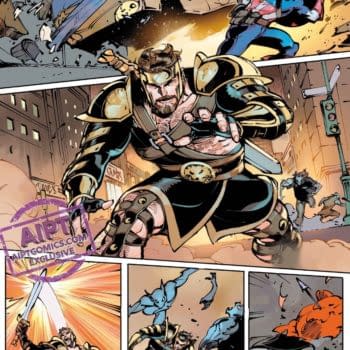Posted in: Comics | Tagged: Artists Against Police Brutality, Christa Cassano, Comics, entertainment, Ghetto Klown, hang dai, Schmuck
Hang Dai's Christa Cassano On Ghetto Klown, Artists Against Police Brutality, and Schmuck
By Nikolai Fomich
Among Brooklyn's best up-and-coming talents, Christa Cassano is a versatile and thoughtful cartoonist, who is using her art as a means to translate candid life experience into four-color comics and speak out against the kind of injustice superheroes don't always tackle. Along with her contribution to Seth Kushner's Schmuck, Christa has recently collaborated with other cartoonists in the Artist's Against Police Brutality anthology and with actor John Leguizamo on Ghetto Klown, a graphic novel about his life. Ahead of Christa, John, and co-artist Shamus Beyale's book signing this upcoming Monday over at The Strand in New York, I spoke with Christa about her life and career in comics.
Nikolai Fomich: Christa, talk a bit about where you're from and your life growing up.
Christa Cassano: I'm from Spokane, Washington, a First Nation Sinixt and member of the Colville Tribe on my mother's side, and a second-generation Italian from Calabria on my father's. They divorced when I was five or six. I had a stepdad for a little while. My mom was a business owner who worked all the time to provide for us, so I was basically raised by a little white lady named Ida Kay, who grew up on the same reservation as my mom. She wasn't authoritarian in the least, so I got to be pretty wild and do whatever I wanted for the most part. But she was incredibly kind and devoted, and the most generous person I've ever known. I have plans to make a little comic about her.
NF: You got involved in comics at a fairly early age. What was the first comic project you worked on?
CC: My first comics series, Mighty Dog, was made at the age of ten. Strangely, describing it as an adult, it suddenly sounds like sexist and racist propaganda! It was about a chow chow who wore a tight turtleneck sweater with a big 'M' on it to show off his muscles, his sidekick, who was a mutt, and FiFi, his poodle girlfriend. I don't remember any of the stories or the mutt's name, so I'll never be certain what kind of brainwashed agenda I was producing. I do have slight memories of the sidekick being dumb and slow, and FiFi being a pretentious, useless pain of a pure breed dog. Oh man, I really hope that wasn't the case.
Anyway, I also started taking oil painting lessons at that time. I would paint puppies and baby deer, and I guess everyone was more impressed by the paintings. So sadly, I abandoned comics. Later, when I dropped out of art school, I discovered Dan Clowes' Eightball and my mind was blown. I was hooked. I told my friends I was going to make a comic one day, but first I'd have to live an interesting life so I'd have something to write about – something wise or important or, at the very least, entertaining to say.
So the next several years were spent traveling around the country, throughout California, Alaska, New Orleans, New York City, and Cape Cod. I took odd jobs, like cleaning up pigeon shit and stone carving debris for a sculptor out in front of Saint John's Cathedral, gutting fish sixteen hours a day, seven days a week, in the middle of the ocean, sketching old people in senior citizen centers, posing nude for odd artists, and a bunch of other menial labor type stuff, including a stint with the circus.
And then I went back to art school, and tried desperately to get better at drawing. I took up sculpture and started painting again, and began showing my art work in galleries and museums. But I never felt like I even slightly belonged in that world. It's pretty awful to admit it, but that scene is mostly some hokey bullshit, I've come to believe. So then, finally, in the fall of 2012, I applied to a graphic novel residency at the Atlantic Center for the Arts and got to study with Dean Haspiel. The next year I joined Hang Dai Studios, drew a story in the late great Seth Kushner's Schmuck, and soon after, got the Ghetto Klown gig.
NF: How was it working with Seth on Schmuck?
CC: First, please let me clarify that Seth Kushner was a mensch, not a schmuck. He was the person who asked me to join Hang Dai and gave me my first official assignment as a collaborator on one of his stories, The Lapdate. I'm happy to say that I am the only female contributor to the book. If you read it, you'll likely understand why there weren't more. But for me, it's all how you look at things, and I was looking at it from the woman's point of view, which, luckily, is what this specific story required. I had a fun time drawing him virgin-like, with sweat beads forming on his forehead, and in one panel, making him look like a cross between Woody Allen and a chimpanzee.
Also, the greatest failure I've ever had as an artist took place right there on his face. He was pressuring me to get the comic done. It had been a while and it appeared as though I was slacking. In actuality, I was paralyzed with fear and got hung up on this one panel, where I had to draw a stripper having an orgasm on him. I was really embarrassed to do it and didn't think what I'd drawn worked. Finally, I figured out that the moment was suppose to be more about his reaction then her orgasm, so I naively cropped a small section containing his head out of a larger drawing and stretched it out in photoshop to produce a close up. Doing so made him look like a burn victim, but when I shamefully brought it to him and showed him, he was fine with it. Everyone else in the studio was shaking their head in disapproval, but Seth let it slide and put it up online like that. I had to convince him later to let me fix it up a bit before it went to print. Having that experience with him really helped me put things in perspective, and not take everything so seriously. He was funny as shit to me, and a great supporter of my work when I really, really needed it. I loved him like a brother, and going through all that awful stuff you go through when one is dying, I don't think I will ever see someone do it more nobly then he did. I don't think anyone could.
NF: You also mentioned your latest project, Ghetto Klown, which you're working on with John Leguizamo. What exactly is Ghetto Klown?
CC: Technically, I'd say Ghetto Klown is John Leguizamo. With a little help from Al Pacino, it's his self-referential alias. It's also his one-man Broadway show, an HBO special, and a new graphic novel, adapted and drawn by myself and Shamus Beyale, with initial layouts by Mike Cavallaro.
NF: Ghetto Klown is candid in both the way it portrays the life Leguizamo has led and in relaying an honest message about creativity, self-doubt, and happiness. What do you think readers can learn from this memoir?
CC: I think readers can learn exactly what I was so grateful to learn from it. It was really important to me to work on this book because I related so much to its content. A lot of my art career before coming to comics, and a very large reason why it took me so long to start making them, is because I was – without exaggeration – crippled and, at times, paralyzed by fear. I've never really been able to understand why it is so painfully humiliating to me to have my work out there in the world, in front of other people's eyes. It has been such a major struggle, that at times I've become physically ill, and suffered similar nervous conditions to the ones John describes in the book.
It's not easy to talk about this stuff, because we're all trying to hold ourselves up to some level of success, and going through that kind of thing feels like anything but that. I think it is so brave of John to speak on self-doubt and, maybe even more so, about prejudice. That is a touchy subject in mainstream America. But he does so with humor and grace. His willingness to share deeply personal good and bad experiences, and knowing him to be the great performer that he is, somehow helped me to see the light at the end of the tunnel, so to speak. I think everybody reading this memoir could be helped in that way.
NF: In addition to Ghetto Klown and Schmuck you've also contributed to the new anthology APB: Artists Against Police Brutality. Talk about that book and why you decided to become involved with it.
CC: Bill Campbell of Rosarium Publishers, who has kindly been following my work since I started a few years back, wrote and asked if I'd like to be a part of APB, explaining that all the proceeds would be going to charity, and of course I said yes. Originally I wanted to do a piece – whether a comic or essay, I wasn't sure – about how moved I was to witness the protests that were happening, because seeing that healed something a little bit in me that got skewed a long time ago.
The first tragic death of a loved one I experienced, that changed the way I would forever see the world, occurred when I was nineteen. Sixteen-year-old Stephanie Snodgrass, who lived with my family and was my little sister's best friend, along with another sixteen-year-old, were killed in a car accident one block away from our house by a highly intoxicated driver with a suspended license for having had too many DUI's. The driver was traveling at 95 miles per hour in our residential neighborhood where the speed limit is 25 mph. He lied and had his friend cover for him as the driver, until the friend found out two people were dead. But the victims were Native American and African American. The driver was white. He received the minimum sentence of six months probation by a white judge.
The judge's kids had went to the same private schools as my brother, my sister, and I for twelve years. We were there when he made the verdict. Had it been the other way around, had the victims been white and the drunk driver and cohort been people of color, no one will ever convince me that the same verdict would have held true. I can't tell you how helpless that all felt, to experience first hand that people of color's lives have so little value in the justice system. That the color of someone's skin matters that much. But we witness this everyday, so when I saw people protesting, people in great numbers not standing for that any longer, I felt a little bit better about the world we live in. Stephanie wanted to be a lawyer. Ironically, she wanted to fight for justice. It's good to see other people wanting to fight for that too.
During my research, I came upon documented statistics that Native Americans are the number one ethnic group killed by cops. This is never mentioned, so I mention it now. I didn't get to create that piece because of crushing deadlines and the need to make money to survive, so instead I did what I could. I made a symbol of hope in a book I knew would be filled with despair. That's the shit that gets me up and out of bed everyday – it's the core reason why I make art.
Many thanks to Christa for taking the time to chat. Follow her on Twitter @christacassano.
Nikolai Fomich is a Philadelphia-based writer and teacher. Follow him on Twitter @brokenquiver.










